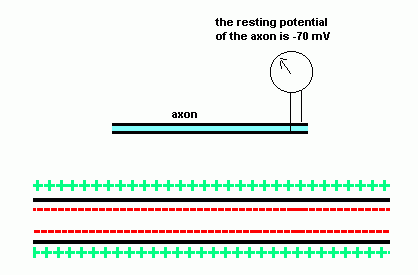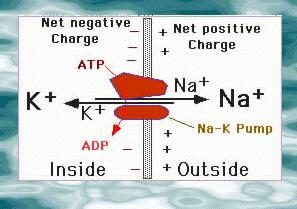CIDPUSA.org Guide Autoimmune diseases
Nerve Physiology-2 Return to page 1
Establishment of the Resting Membrane Potential
Membranes are polarized or, in other words, exhibit a RESTING MEMBRANE POTENTIAL. This means that there is an unequal distribution of ions (atoms with a positive or negative charge) on the two sides of the nerve cell membrane. This POTENTIAL generally measures about 70 millivolts (with the INSIDE of the membrane negative with respect to the outside). So, the RESTING MEMBRANE POTENTIAL is expressed as -70 mV, and the minus means that the inside is negative relative to (or compared to) the outside. It is called a RESTING potential because it occurs when a membrane is not being stimulated or conducting impulses (in other words, it's resting).

What factors contribute to this membrane potential?
Two ions are responsible: sodium (Na+) and potassium (K). An unequal distribution of these two ions occurs on the two sides of a nerve cell membrane because carriers actively transport these two ions: sodium from the inside to the outside and potassium from the outside to the inside. AS A RESULT of this active transport mechanism (commonly referred to as the SODIUM - POTASSIUM PUMP), there is a higher concentration of sodium on the outside than the inside and a higher concentration of potassium on the inside than the outside.

The nerve cell membrane also contains special passageways for these two ions that are commonly referred to as GATES or CHANNELS. Thus, there are SODIUM GATES and POTASSIUM GATES. These gates represent the only way that these ions can pass through the nerve cell membrane. IN A RESTING NERVE CELL MEMBRANE, all the sodium gates are closed and some of the potassium gates are open. AS A RESULT, sodium cannot diffuse through the membrane & largely remains outside the membrane. HOWEVER, some potassium ions are able to diffuse out.
OVERALL, THEREFORE, there are lots of positively charged potassium ions just
inside the membrane and lots of positively charged sodium ions PLUS some
potassium ions on the outside. THIS MEANS THAT THERE ARE MORE POSITIVE CHARGES
ON THE OUTSIDE THAN ON THE INSIDE. In other words, there is an unequal
distribution of ions or a resting membrane potential. This potential will be
maintained until the membrane is disturbed or stimulated. Then, if it's a
sufficiently strong stimulus, an action potential will occur.
Contact CIDPUSA.org through services section link on home page. Search this web site 5000 pages